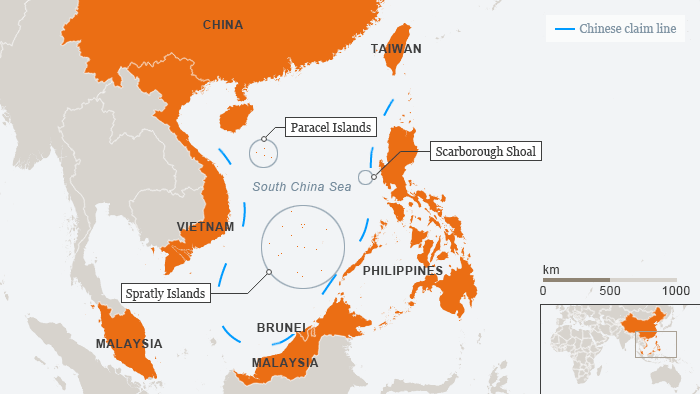The South China Sea
Judgment in the dispute Philippines vs. China is
Next Tuesday the court of arbitration wants cases in The Hague, a judgment to the Navy in the South China sea. Deutsche Welle answered some basic questions about the internationally acclaimed process.

What is the charge to the Philippines?
22. January 2013 appealed to the Philippines to the Permanent court of arbitration in The Hague. Simplified, it goes to the Philippines to clarify the following three issues:
- What is the legal Status of the claims of the people’s Republic of China in the South China sea, in particular the so-called Nine-dash line?
- It is in the controversial surveys in the South China sea to be Islands, rocks, or just so-called “dry case at the end of surveys”, land surfaces, which extend only at low tide from the water? Islands entitle in international law, namely, to all other territorial claims than about rocks.
- The court of arbitration shall determine whether China has operated illegally within the Exclusive economic zone of the Philippines and the Philippines has been prevented from using its economic zone.
The Philippines do without, in their view, explicitly to clarify the question to whom sovereignty over the Islands, reefs and rocks in the disputed Region. It was only to questions of interpretation of the law of the sea Convention (UNCLOS).
The subject matter of the dispute, some of the Spratly Islands, in the South China sea over more than 420,000 square kilometres, and various residents, controlled, as well as some of the other reefs and rocks are. This includes Scarborough Shoal, Second Thomas Shoal”,” Gaven reef and Reed Bank.

The international law of the sea regulates, among other things, the rights and obligations of States in the waters off their coasts have
What is the legal basis?
The Philippines called on the
The law of the sea the United Nations Convention (UNCLOS), to which one, after years of negotiations in 1982 had agreed on, and which came into force in 1994. In addition to the 165 other Nations, the Philippines and the people’s Republic of China have signed the agreement, but not the US.
China relies on the Naval historical rights and on a number of controversial historical evidence which date back to the Ming dynasty. However, historical issues are outside the jurisdiction of UNCLOS.
All signatories to the Convention have committed themselves to the peaceful settlement of disputes. A mechanism for the discharge of a dispute before a court, and even then, if a party to the dispute refuses such a procedure. In this case, the arbitration comes to the train. So also in the case of the Philippines against China.

The Spratly Islands in the South China sea
The court of arbitration has jurisdiction.
19. February 2013, the people’s Republic of China rejected the initiative of the Philippines and denied the jurisdiction of the court of arbitration.
According to the PRC, it is in the application of the Philippines, ultimately, to questions of sovereignty and the drawing of Maritime borders. In other words, don’t go to questions of interpretation of the law of the sea, but territorial issues. The in excess of the jurisdiction of an arbitral Tribunal.
Also see UNCLOS, disputes are negotiated and resolved. Two agreements between the ASEAN and China from the Chinese point of view, the appropriate basis for the ASEAN-China Declaration on the Conduct of Parties in the South China Sea (2002), and the ASEAN Treaty for Amity and cooperation (1976). The Philippines, in turn, explain that all attempts at Negotiation on the basis of these agreements by China, blocked or deported.
The court was on the 29. October 2015, despite the objections of the PRC known to initiate the proceedings, however, are not taken into account all of the Philippines mentioned points. It was only for questions of interpretation or application of UNCLOS jurisdiction.
China insists on his view of things. It does not recognize the jurisdiction of the court and participates in any way in the proceedings.
What is it with the Nine-dash line?
The Nine-dash line (sometimes Ten – or Eleven-and-dashes line) of the Republic of China (Taiwan) in 1947, for the first time on an official map published flag, which should represent the territorial claims of the Republic of China in the South China sea.
The line was taken over by the people’s Republic of China, and is currently also the official claim of the PRC.
The problem is the line is because it is in at least two respects unclear:
- It was never exactly, so in a latitude and longitude defined, where the strokes are exactly.
- China has also declared never, if it does only claim to be within the lines of the Islands, reefs and rocks, from which it then claims to the sea after UNCLOS derived would be, or whether it is the entire area claimed within the lines as a territory.
International experts are largely in agreement that the Nine-dash line is from the point of view of international law is durable.

The Nine-Dash Line
What follows from the arbitration award?
The decision of the court is, according to the UNCLOS is binding on the parties. It is in accordance with Annex VII of UNCLOS is final and cannot be appealed. Theoretically, both States would have to recognise the judgment and the arbitration award will follow. However, the court of justice in The Hague has no way of judgment into practice.
At the most, could penetrate a signatory of UNCLOS to the fact that China is losing its advantages as a member of the three under UNCLOS established authorities. These are the International Tribunal, the International seabed authority and the Commission on the limits of the continental shelf. China could be invited, a judge from the International Tribunal in Hamburg to deduct or pending proceedings with China’s participation in the Commission on the limits of the continental shelf could be put on ice.